PROVINCEOF






PATRONATO PROVINCIAL DE TURISMO DIPUTACION DE CADIZ Plaza de Madrid s/n Estadio Nuevo Mirandilla – Fondo Sur 4ª planta. 11011 Cadiz Telf: 0034 956 807 061 info@cadizturismo.com www.cadizturismo.com
www .cadi zturismo.c om

From a bird’s eye view, the province of Cadiz is a beautiful mo saic of landscapes. This is the result of the privileged geogra phical location of the territory. Located between two seas and overlooking the African continent, this territory is distincti ve for its natural setting and diverse character of the landscape. Considering the numerous environments of great ecological va lue and the administrative protection of its territory, 38 % of the surface area of the province of Cadiz is included in the Network of Protected Natural Spaces of Andalusia. Human activity has transformed the landscape and created new habitats, such as salt marshes, vineyards and countryside where birds have managed to adapt.
To speak of the province of Cadiz is to speak of mountains, bea ches, forests, dry crops, vineyards, rivers, marshes, saltpans, pastures, cliffs, sea..., and of course of the living beings that inhabit it.
The Strait of Gibraltar is the most important point for the observation of the Western Palaearctic glider migration. Around 30 million birds use it every year at least twice a year during their migrations.
The province of Cadiz stretches like an arm of land towards the African continent. Its very close proximity to Africa, 14 km at its narrowest point, makes Cadiz a unique place used by thousands of birds to make their annual migrations between the two continents. In this sense, the province acts as a funnel for sou th-bound migrants, channelling a large number of European migratory birds on their way to their wintering grounds in Africa. And it is also the arrival point for thousands of north-bound migrants on their way to Europe for breeding.
Villamartin
Trebujena Sanlucar de Barrameda
Chipiona
Rota Puerto de Santa Maria
Jerez de la Fra.
Espera Bornos
Puerto Serrano Prado del Rey
Arcos de la Fra San Jose del Valle
Olvera
Algodonales
Zahara de la Sierra El GastorGrazalema
Torre Alhaquime Alcalá del Valle
Setenil de las Bodegas
Algar
Villaluenga del Rosario Ubrique
El Bosque Benaocaz
Puerto Real Chiclana de la FraSan Fernando
Cadiz
Medina Sidonia Alcala de los Gazules Benalup Casas-Viejas
Paterna de Rivera San Martin del Tesorillo
Conil de la Fra Vejer de la Fra. Barbate
Jimena de la Fra
Castellar de la Fra
Los Barrios San Roque
Tarifa
Algeciras La Linea de la Concepcion
Cadiz, a natural mosaic
- Natural regions in the province of Cadiz -
With this ornithological calendar we will embark on a journey through the province of Cadiz: in time, over twelve months, and in space, through each of the six natural regions that make up the landscape of the province. In this trip, six ornithological destinations are proposed for each of the months of the year (one for each region). What?, When? and Where? are some of the topics that this publication aims to explore.
The journey begins with a brief tour through each of the natural regions of the province of Cadiz, highlighting their natural and ornithological landmarks. Subsequently, we travel in time throu gh an annual phenology cycle of the birds that we can see in the province. Here, different hotspots and routes are proposed for their observation in each of the regions.
There are 72 proposals for birdwatching in the province of Cadiz: one for each region and month of one whole year.
The descriptions of each of the routes proposed in this ornithological calendar are included in factsheets at the end of each month. There are QR codes with links to download the files that contain all the geographical information you need for GPS or smartphones. This way, the reader is provided with the geographical location of each of the routes or observation points compiled for each month and region. Once the QR code has been read, the file can be downloaded and the geographical information will appear in kml format. The free, ad-free Mapas de España app from the Spanish National Geographic Institute is a highly recommended option for viewing the points or itineraries on any smartphone.
Description

Use a mobile phone to scan the QR code included in each of the proposals. You will need to use your mobile phone camera to do this.
Once the QR code has been read, a link to the file containing the geographic infor mation in kml format will appear on the screen. Download the file to use it.




Open the file. To use the file, you will need to have installed an APP for reading kml files on your mobile phone.

This Top 10 includes the ten most iconic species of the province of Cadiz chosen for their beauty, uniqueness in the territory, scarcity, degree of threat, distribution, and taking due consideration of all the distinctive and diverse habitats present in Cadiz.
Each birdwatcher will undoubtedly have his or her own particular Top 10. However, this selection was made according to the criteria mentioned above and building on the immense richness and diversity that Cadiz has in terms of birds. We have tried to cover as many groups of birds as possible: eagles, vultures, waterfowl, passerines, ibis, pelagic seabirds, gulls, rails and swifts. We have included birds that are singular and infrequent in other areas of Andalusia, that are difficult to observe due to their degree of threat and low density, and of course, that are mentioned and distributed throughout the six regions that make up the most varied and complete province of the whole of Spain.
As an emblem of the Iberian fauna and catalogued as endangered, this endemic species of the peninsula is a regular nester in Cadiz. Extinct as a breeder in the province, it has once again reproduced and its numbers continue to rise.
Classified as one of the ten most endangered species on the planet. Thanks to a reintroduction project by the Junta de Andalucia and the Zoo and Botanical Garden of Jerez, Cadiz has the only breeding population of Bald Ibis in Europe.



A common nester in rocky areas and cliffs. On rare occasions it also breeds in large trees. In danger of extinction at a national level and with a downward trend throughout the country, it is still common in the province of Cadiz.

Originally from Africa, it crossed the Strait of Gibraltar at the end of the last millennium and colonised the province of Cadiz. With its re production recorded since 2000 in the Sierra de la Plata (Tarifa), it has been spreading to other places in the west of the province.

A very abundant species in the province of Cadiz a century ago. Today, it is the most endangered waterfowl on the entire European continent, being in critical danger of extinction at a national level.
With a mainly African distribution, it is a very scarce breeder in the province of Cadiz. This fact posits an exceptional singularity to Cadiz avifaunal diversity. Critically endangered at a national level, the number of pairs fluctuates around 20 pairs in the province.

Classified in danger of extinction at a national level, it arrives every spring from Africa to nest in the province. Among the traditional vineyards and wild olive groves, with little influence of pesticides, the rarest of the Iberian passerines still breeds.

Stylish and very elegant, it is a particularly scarce and endangered gull, with a very limited distribution in the world. Associated with saltpans and brackish areas of the Cadiz coast, it is a common nester in the west of the province.

African vulture of sub-Saharan distribution, which colonised the province at the end of the last century. Slightly smaller than the Griffon Vulture and with more mottled covert feathers, it is a regular visitor to the carrion of livestock that die in the Strait of Gibraltar.

With two subspecies, diomedea (Mediterranean region) and borealis (Ca nary Islands), this shearwater species is in severe decline. In its entries and exits to the Mediterranean, spring and autumn migrations, the most frequent sightings occur close to the coast, mainly in the Strait of Gibraltar.

al oeste de la provincia y formada por los municipios de Cadiz, Chiclana de la Frontera, El Puerto de Santa María, Puerto Real y San Fernando, la comarca de la bahía de Cadiz esconde grandes tesoros ornitológicos entre sus marismas, caños y salinas. Con una vida influenciada claramente por la acción de las mareas y por la actividad humana, que transformó sus paisajes originales para el uso y aprovechamiento de los recursos naturales, la biodiversidad de esta comarca queda reflejada en la variedad y riqueza de su avifauna.
Located in the west of the province and made up of the muni cipalities of Cadiz, Chiclana de la Frontera, El Puerto de Santa Maria, Puerto Real and San Fernando, the region of the Bay of Cadiz hides great ornithological treasures among its marshes, water channels and saltpans. Clearly influenced by the action of the tides and human activity, which transformed its original landscapes for the use and exploitation of natural resources, the bio diversity of this region is reflected in the variety and richness of its birdlife.

The heterogeneity of the ecosystems present in the region: marshes, beaches, rivers, water channels, lakes, saltpans, intertidal flats, estuaries, pine forests, etc., as well as the urban centres themselves and their green areas, translate into uniqueness, diversity and abundance of birds. Furthermore, its location in the middle of the Europe-Africa migratory route, the great availability of accessible food in the region (the marshes are the second most productive ecosystem in the world) and the good weather mean that birdwatchers can enjoy their passion in the Bay of Cadiz all year round.
In an annual tour through the region, there are many highlights that the reader can discover through this ornithological calendar. Undoubtedly, the exceptional concentrations of waders, the huge flocks of Eurasian Wigeons and Spoonbills in the internal shores and the high number of Ospreys are some of the not-to-be-missed birding events in the Bay of Cadiz.

Natural regions of the province of Cadiz
The largest lake in the Iberian Peninsula until its drying up in the 1960s. La Janda is an extensive and beautiful region that includes the municipalities of Alcala de los Gazules, Barbate, Conil de la Frontera, Benalup-Casas Viejas, Medina Sidonia, Paterna de Rivera and Vejer de la Frontera. Marked by a great di versity, ranging from the heart of the Los Alcornocales forests to the cliffs of La Breña, the region of La Janda brings together unique places to enjoy memorable birdwatching moments.

With places of international importance for birds, the region of La Janda has all the attractions to be one of the best places for birdwatching in Europe. Some hotspots are the old lake of La Janda (today in the process of recovery promoted by the Association of Friends of the Laguna de la Janda), the breeding colonies of Northern Bald Ibis in La Barca de Vejer and the Castilnovo Tower in Conil de la Frontera, the Barbate marshes, the Los Alcornocales

Natural Park, etc., and rare species of high value for birdwatchers, such as the nesting Iberian Imperial Eagle, Osprey and Bald Ibis, and wintering species such as the Common Crane.
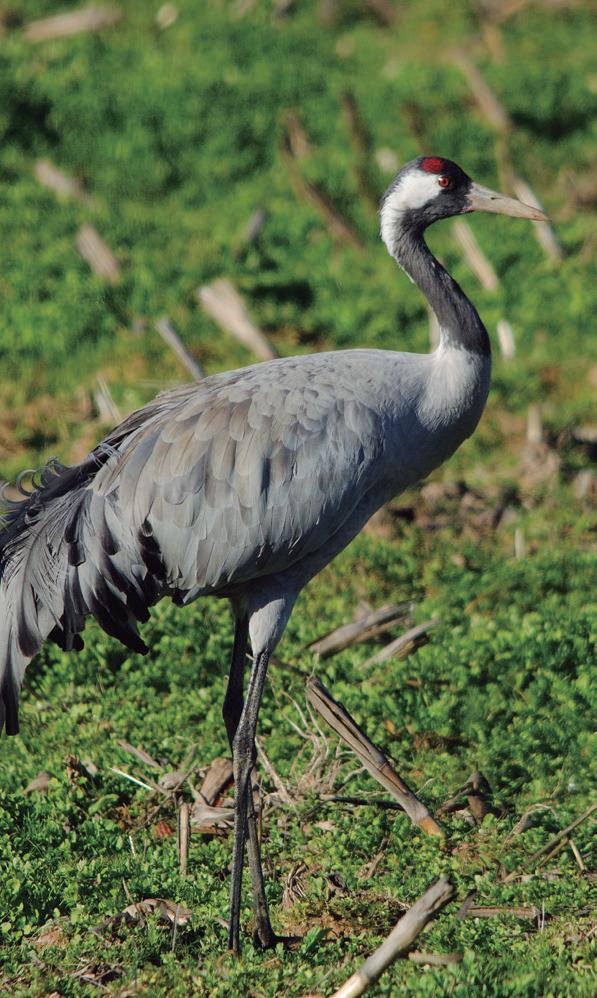

In the north of the province of Cadiz, bordering Seville and Ma laga, lies the mountainous region of the Sierra de Cadiz. Made up of 19 municipalities, it is the region with the most villages of the six in the province of Cadiz. Alcala del Valle, Algar, Algodonales, Arcos de la Frontera, Benaocaz, Bornos, El Bosque, El Gastor, Espera, Grazalema, Olvera, Prado del Rey, Puerto Serrano, Setenil de las Bodegas, Torre Alhaquime, Ubrique, Villaluenga del Rosario, Villamartin y Zahara de la Sierra make up this beautiful mosaic of white villages, mountains and countless birds.
The charm of its white villages and the countless natural attrac tions of this land make up a spectacular landscape that guarantees the admiration of the most demanding visitor. The variety and exclusivity of the ecosystems of this region: high mountain meadows, rocky areas, cork oak groves, holm oak forests, Spanish fir forests, Algerian and gall oak forests, pine forests, Mediterranean scrubland, riverbanks, lakes, etc., are home to a very diverse and unique birdlife. Species that are very difficult to find in other
parts of the province, such as the Golden Eagle, the Red-billed Chough, the Common Rock Thrush, the Rock Sparrow, the Alpine Accentor or the Ring Ouzel, among others, can be regularly watched in the Cadiz mountains. To all this wealth of birds and scenery, we must add the presence of other abundant natural tre asures, such as Lepidoptera (butterflies and moths), amphibians and orchids, which are sought after and photographed every year by the many naturalists who visit the region.


Although it is made up of only two municipalities, Jerez de la Frontera and San Jose del Valle, the Jerez countryside covers a large area of land within the province of Cadiz. Mostly made up of farmland (vineyards, cereal crops, etc.), this region also has a large area of woodland, like the Montes de Propios in the Los Alcornocales Natural Park, and other areas of scrubland and low hills around the two municipalities, which are of great natural value.



Ornithologically speaking, and with the occasional exception of the Medina Lake, a renowned wetland among birdwatchers, the Jerez region is largely unknown to today’s birdwatching enthusiasts. This is indeed paradoxical, since it was precisely in the city of Jerez de la Frontera in 1952 where the first mee tings for the foundation of the Spanish Ornithological Society (SEO BirdLife) were held. In the district of Jerez there is a large
Natural regions of the province of Cadiz
number of ecosystems of high ecological value for birds, inclu ding excellent areas for steppe birds, the banks of the Guadalete river, cork oak forests, pine forests, pastures, lakes and other seasonal wetlands, large expanses of vineyards, urban and periurban parks, historic buildings, etc. Together, they all create a magnificent combination of elements that are home to a large number of birds.
This region extends along the final stretch of the Guadal quivir estuary, on its left bank. With a wine and seafaring tradition, and made up by the municipalities of Chipiona, Rota, Sanlucar de Barrameda and Trebujena, this region overlooks the Atlantic from a privileged location. The richness of its estuary and the high biodiversity of its ecosystems make it a unique place, capable of hosting thousands of birds among its marshes, estuaries and saltpans.



Having part of its territory included within the Doñana Natural Park is synonymous with being an excellent place for birdwatching. Likewise, its natural and transformed marshes, estuaries, saltpans, pine forests, lakes, fishing weirs projecting out into the sea, vineyards, etc., make up a mosaic of foraging places and wa ter availability, which make this region a recommended place for birdwatching all year round. If we also take into account the lar-
ge number of species that can be observed, as well as the singu larity and scarcity of many of them (Little Swift, Marbled Duck, White-headed Duck and Slender-billed Gull), more than a recommendation, a visit to the Northwest Coast becomes practically an obligation for any birdwatcher looking to enjoy a special birdwat ching day out.
Themunicipalities of Algeciras, Castellar de la Frontera, Ji mena de la Frontera, La Linea de la Concepcion, Los Barrios, San Martin del Tesorillo, San Roque and Tarifa make up the Campo de Gibraltar, which is the southernmost region of the province of Cadiz and, therefore, of the entire European continent. The southern location of this region, at a crossroads between two continents, washed by the Mediterranean and the Atlantic, and swayed by east and west winds, shapes the character of a land full of exuberant nature, a magic place where bird migration takes on unparalleled dimensions.



As described in this birdwatching calendar, the Campo de Gibral tar offers us an infinite number of possibilities all year round, with excellent locations and thousands of opportunities to enjoy great birdwatching moments. It is the phenomenon of migration as a whole what undoubtedly marks the identity of this place. The spectacular sight of large flocks of White Storks, the beauty of a sky filled with birds of prey, the majesty of a Vulture almost three metres in size crossing the Strait, the striking sight of small birds struggling to reach the other shore and the constant move ment of seabirds to and from the Atlantic Ocean and the Mediterranean Sea, mean that every year during the spring and autumn, the Campo de Gibraltar is a true birdwatching festival with observers arriving from all corners of the planet to enjoy the migration.
Natural regions of the province of Cadiz

The winter cold across most European countries makes the southernmost province of continental Europe the wintering place for millions of birds during the winter months.
Here, a unique event takes place in Spain. Arriving from most European countries, the inner shores of the bay host the highest concentration of Great Crested Grebes in the Iberian Peninsula It is also the best time of the year to find surprises such as loons and mergansers, as well as the highest concentrations of wintering waterfowl.
 Great Crested Grebe
Great Crested Grebe

Although this migration has already started in a quiet way in the previous months, it is in January that thousands of White Storks, mainly from the Iberian population, cross the Strait of Gibraltar and arrive on the peninsula, driven by the urge to breed. On days with favou rable weather, especially low wind, it is quite a spectacle to see them return to Europe.

La Janda is undoubtedly a unique encla ve in Europe to observe the flight of the eagles in winter. It is home to nesting pairs of Iberian Imperial Eagle and Bonelli’s Eagle. Also juveniles of these and other eagles, such as the Golden Eagle and the rare Lesser Spotted and Greater Spotted Eagles, come here, attracted by the abundance of prey and the mild win ter climate.
Announcing the change of the season and the approach of the coming spring, the arrival of Hirundinidae across the Guadalquivir is increasingly widespread. During this month, thousands of swallows and house martins begin their migration from Africa, with the Guadalqui vir estuary and the two banks of Doñana being one of the main access routes to the European continent.



Thousands of Northern Shovelers, Eurasian Teals and many other wintering waterfowl are concentrated in the lakes and wetlands of the Jerez Countryside. The Medina Lake is undoubtedly the wetland that is home to the greatest number of these birds, and also the ideal place to look for the unique Red-knobbed Coot, Marbled Duck or the scarce Ferruginous Duck.
Although winter is at its peak and the cold dominates the mountains, the king of the mountains, the Griffon Vulture, is already beginning its courtship rituals. Their activity is frenetic and it is the best time to see their beautiful flights in pairs, their copulations on the wing and their comings and goings, bringing material to the nests of the numerous breeding colonies in the mountains.






Binoculars recommended.
Telescope recommended.
On foot. Route or itinerary.
By car.Two itineraries are suggested in the Medina Lake Nature Reserve (Jerez de la Frontera): the Malva sia viewpoint, and the Medina Lake observatory. White-headed Duck, Eurasian and Red-knobbed Coots, and an endless number of waterfowl can be observed from these places.
Now dried up, the Janda lake was once the largest lake on the Iberian Peninsula. Even so, it is still a must-see destination for birdwatchers and an excellent place to observe large birds of prey scattered around the area.
In the heart of the Natural Park, in the municipality of Grazalema, the viewpoint of Puerto de Las Palomas offers a magnificent panoramic view to enjoy the nuptial flights of the Griffon Vulture.
A pleasant walk along the shores of the beaches of Sanlucar de Barrameda and Chipiona will allow us to observe Swallows and Common House Martins on their arrival in Europe.
This is a good option for observing Great Crested Grebes and other wintering water fowl. This itinerary runs in the city of Cadiz parallel to the shore of the inner part of the bay.
In light wind conditions, the Bolonia pass (Tarifa), in the heart of the Strait of Gibraltar Natural Park, is the ideal place to enjoy the view of large flocks of White Storks on their return to their breeding grounds.

Although still the winter season, February is a month with a very spring-like atmosphere in Cadiz. The birds understand this, and many species declare the breeding season open in our province.
The Eurasian Spoonbill is one of the most representative bird species of the marshes of the Bay of Cadiz Natural Park. The more northerly populations, mainly the Dutch, are still a long way from the start of their breeding. However the local population has already begun preparations for the new breeding season, with the first clutches being laid at the end of this month.
Associated with the population explosion of caterpillars, the Great Spotted Cuckoo, one of the two European species of cuckoo and a natural predator of caterpillars, arrives from Africa and can be observed in the region feeding on these invertebrates.
 Great Spotted Cuckoo
Great Spotted Cuckoo

Before their departure to their breeding grounds in northern Europe, February is a great time to observe wintering birds in the Sierra de Cadiz. Ring Ouzels, Alpine Accentors and Redwings , among others, spend their last hours in the mountains and recharge their batteries before setting off on their next journey. Cerro Coros, near Puerto de las Palomas, is an excellent place to observe them.

The smallest of the Iberian sparrows, the Eurasian Tree Sparrow , is already preparing for the breeding season and is begin ning to occupy hollows of trees and nest boxes in the pine forest of La Algaida.



The numerous pairs of White Storks scattered throughout the Jerez region are already occupying their usual nesting areas. They are constantly coming and going, providing material and restructuring their old nests in preparation for the imminent breeding season. An example is the old sugar factory of El Portal, where the sight of a foreign stork approaching the resident’s territory raises an intense bill-clattering noise to remind the intruder that the nest is occupied.
The locally called “wind eagles” are beginning to arrive in greater numbers over the skies of the Campo de Gibraltar. Depending on the direction and the intensity of the wind, Black Kites start crossing the Strait from the African continent either by the Mediterranean or the Atlantic side of the coast. On days with light or moderate easterly winds, the area of Punta Camorro in the vicinity of Tarifa is an exceptional place to observe their arrival in Europe from Africa, where they have spent the winter.






Currently in ruins, the building of the old su gar factory of El Portal (Jerez de la Frontera) is home to one of the most spectacular colonies of White Storks in the province of Cadiz.
Between the farmhouses of La Mediana and Los Charcones (Benalup-Casas Viejas) there is a holly oak grove, an ideal place to observe the Great Spotted Cuckoo during the month of February.
Binoculars recommended.
Telescope recommended.
Cerro Coros (Grazalema) is a good option for observing wintering birds before they set off on their migratory journeys.
The Algaida pine forest in Sanlucar de Barra meda is home to a great diversity of small forest birds.
La Caseria beach in San Fernando offers an unbeatable opportunity to observe large concentrations of Eurasian Spoonbills, among others.
With a light easterly wind and good visibility in the Strait of Gibraltar, the observatory at Punta Camorro (Tarifa) is a good location to enjoy the spring bird migration spectacle.
Although some summer species, such as the sthe Barn Swallow and the House Martin, have already made their presence felt, March is the month when migration becomes truly visible with the arrival of thousands of birds from Africa.
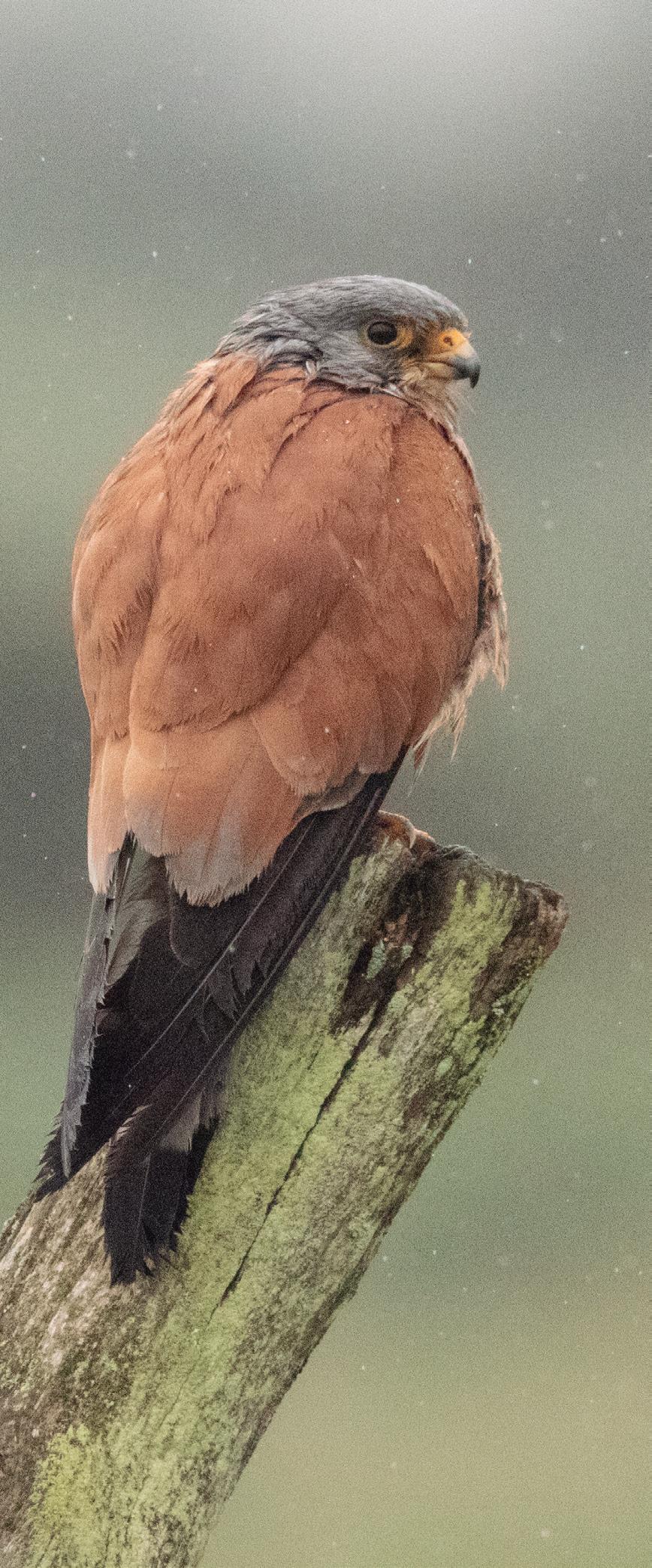
The increase in daylight hours and the improvement of the climate in northern Europe is a message that does not go unnoticed by most birds. Breeding has made its call and thousands of waders are feeding in the tidal flats, marshes and salt marshes of the Bay of Cadiz, making a stop on their migratory journey to the breeding grounds.

Considered one of the ten most endangered birds on the planet, the Bald Ibis is a regular nester in the Janda region. After its reintroduction by the Regional Ministry of the Environment and the Zoo and Botanical Garden of Jerez, a breeding colony was established in La Barca de Vejer, in 2011, where at this time of year it is common to see them in full courtship.

The silhouette of the smallest and most endangered of the vultures that nest in the province of Cadiz, the Egyptian Vulture, can alre ady be seen in the sky over the mountains. In addition to the breeding pairs, which are already patrolling their usual territories, in the mountains it is also possible to see Egyptian Vultures on their migratory journey to more northerly territories.

Breeding has begun for many species, and the sight and sound of a ‘pajarera’ , the congregation of tree-nesting birds, is quite a spectacle. Glossy Ibis , Eurasian Spoonbills, Little Egrets, Cattle Egrets, Squacco Herons and Black-Crowned Night Herons nest together” on the tamarisks of the central island of the Tarelo Lake.

During the great migrations of soaring birds between the European and African continents, spring and autumn, March is the month par excellence to see the thousands of birds arriving from Africa. Driven by their breeding instinct, thousands of Booted Eagles, Short-toed Snake Eagles, Egyptian Vultures and Montagu’s Harriers, among others, arrive in Europe during this month.



The grasslands and cereal fields of the Jerez countryside have already reached a considerable size. After its arrival from Africa, the beautiful Montagu’s Harrier does not waste a second and is already searching among the green fields for the best location for its nest.







The route runs along the CA-6014 to the A-471 along the Carretera del Calvario (Jerez de la Frontera). Along this route it is possible to observe the elegant flight of the Montagu’s Harrier over the Jerez countryside.
The observatory of the breeding colony of the Bald Ibis at La Barca de Vejer is the only one in the world that allows you to observe this unique species at close range.
Currently abandoned, the Tres Amigos Salt Mine (San Fernando) supports a large number and variety of waterfowl and waders. This trail in the Bay of Cadiz Natural Park has three bird observatories.
Binoculars recommended.
Telescope recommended.
This trail runs from the Boyar Pass to Benao caz in the interior of the Sierra de Grazalema Natural Park. The beauty of the karstic landscape and the flight of Griffon Vultures and Egyptian Vultures are some of its attractions.
In the heart of the La Algaida pine forest, in Sanlucar de Barrameda, Tarelo Lake is located. With a broad belt of riparian vegetation, this lake hold a good variety of waterfowl, herons and egrets
The Punta Carnero viewpoint is one of the most visited places by birdwatchers who en joy watching soaring birds during the spring migration.


The colour of flowers and the sound of courting birds announce that spring is here to stay. The brightness of the breeding plumage, their songs and the smell of wild plants make April a spectacle for our senses.
In addition to the gliders, other smaller birds such as European Bee-eaters , European Rollers, European Turtle Doves, Collared Pratincoles, Golden Orioles and Common Cuckoos are arriving from Africa and continue to bring variety and colour to the Campo de Gibraltar spring. Although there are areas of greater prevalence, the unpredictability of their arrival –they do not rely on air currents to cross the Strait– make any pole, cable or fence near the coast a good place to try to observe them.
The frenzied activity of adults in their breeding colonies makes this a great time to observe one of the scarcest species in the whole of Europe: the Little Swift.


When the winter rains have been plentiful, the Paraje Natural Cola del Embalse de Bornos is a very interesting spot for birdwatchers. A wide variety of protected species are concealed among its marshes, including ornithological gems such as the Western Olivaceous Warbler, the Purple Heron, the Black-Crowned Night Heron and the Squacco Heron, among others.
The mixture of migrants and breeding birds creates a magnificent cocktail of biodiversity that translates into an end less number of species worth observing. This is a perfect time to look for small migrating birds and species such as the Subalpine Warbler, the Common Reds tart and the Willow Warbler, which can be observed on their journey north.

Here we can observe one of the birds of prey that has been with us for the shortest time, as it searches through the fields and small meadows of the Jerez countryside in its typical hunting flight, or perches on the top of a tree. Originally from Africa, the Black-winged Kite arrived in Europe only a few decades ago and has been colonising the Iberian Peninsula ever since.

Increasingly difficult to observe due to the farming intensification of our fields, the Montagu’s Harrier resists extinction in La Janda. This region is one of the best places to observe it in the province.







Binoculars recommended.
Telescope recommended.
On foot. Route or itinerary. By car. Observation Point.
Along the so-called Cortes road (A-2003), be tween the districts of Estella del Marques and La Barca de la Florida and the municipality of San Jose del Valle, it is common to see the Black-winged Kite.
Between the cemetery of the local autono mous municipality of Tahivilla and the fish flour factory, the Las Dehesillas road runs along a path flanked by agricultural plots. It is an exce llent place to observe the Montagu’s Harrier.
During the walk through the old saltpan of Carboneros (Chiclana de la Frontera), you can observe breeding birds such as the Pied Avo cet or the Black-winged Stilt, as well as small migrating birds.
A walk through the Natural Site named Cola del Embalse de Bornos is a perfect excuse to enjoy the observation of different species of birds, many of which are endangered.
At this time of the year, the porch of the mari na of the town of Chipiona offers the possibility of observing the Little Swift. This African species has recently made the leap to Europe.
A walk along the Pajarraco Gorge path in the pine forest of El Rey in San Roque will allow us to see or hear some species such as the Common Cuckoo or the Golden Oriole.

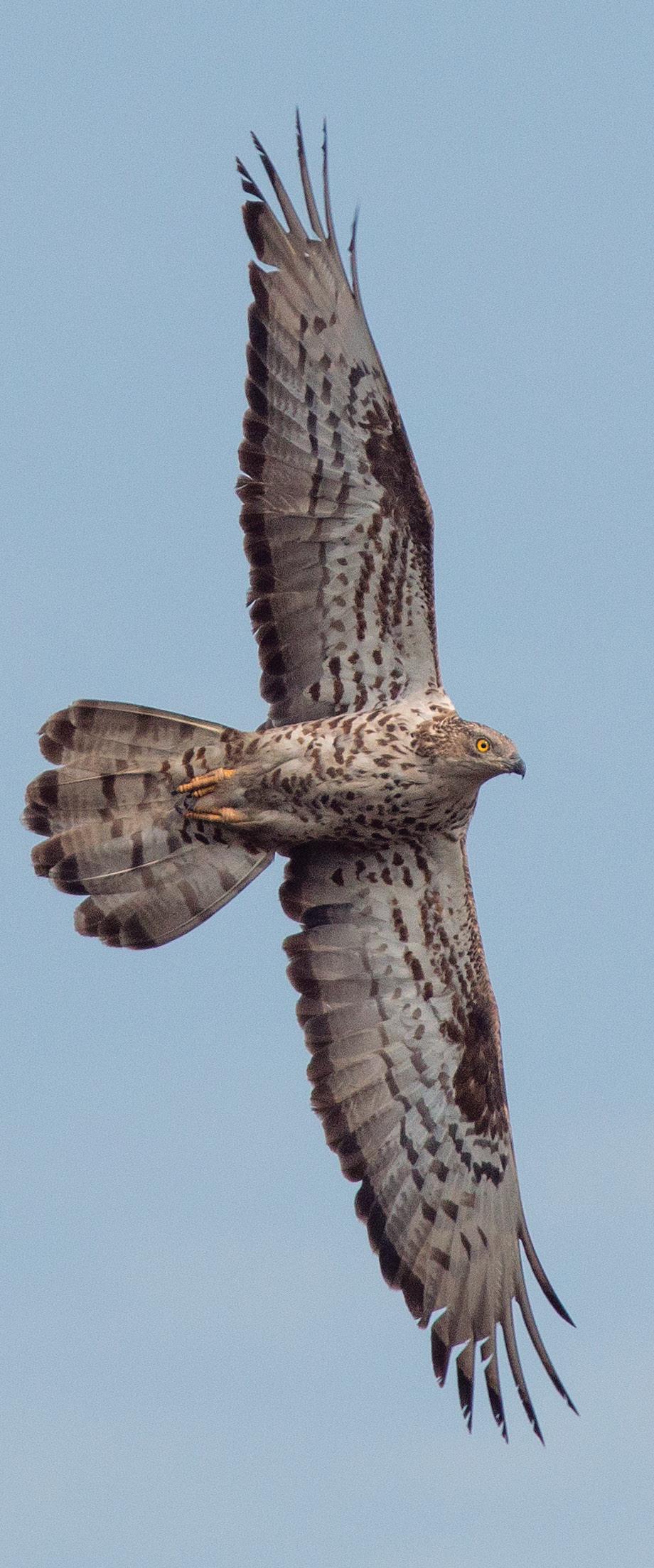
The countryside is full of life and the chicks of many species have already hatched. The newborns are following on the footsteps of their parents and quickly learning everything that will help them increase their resilience to successfully face the first adventures of their lives.

A stroll along the banks of the Guadalete river will allow us to enjoy a myriad of bird songs that are concealed among the reeds: Melodious Warblers , Western Olivaceous Warblers and Cetti’s Warblers, among others. In the middle of this magnificent range of high-pitched calls, we might even be able to pinpoint one of nature’s best architects of nest construction: the Eurasian Penduline Tit.

The new generations of birds are already following their mothers in the lakes of the region. This is the case of one of the most threatened ducks in Europe, the White-headed Duck, which finds here one of the best nesting places in the whole peninsula.

The most colonial and urbanite of all the falcons that nest in the province of Cadiz, the Lesser Kestrel, finds the chur ches and castles of the villages of La Janda are perfect places for breeding.

Prime examples are the municipalities of Alcala de los Gazules, Medina Sidonia and Vejer de la Frontera.
Belonging to the tern family, the Gull-billed Tern is a summer visitor that comes to our province to complete its breeding period. Although linked to wetlands for the construction of its nests, the Gull-billed Tern is a frequent hunter of inland areas and it is common to see it among farmlands searching for small reptiles, micromammals, etc., unlike the majority of its congeners.
Although most of the soaring birds have already arrived in Europe and are fully devoted to reproduction, the last to arri ve, the European Honey Buzzard, has its migration peak in the first days of this month. With good visibility and a moderate to strong easterly wind, the Sierra de la Plata is an exceptional place to observe the arrival of the numerous flocks of this unique species.

After its arrival from Africa, the Little Tern returns, as it does every year, to its usual nesting area in the Marisma de Los Toruños and Pinar de la Algaida Metropolitan Park. On the Levante beach and protected by a fence to avoid any distur bance, you can enjoy the comings and goings of the smallest of the European terns, in what is curiously the largest colony in the country.







Binoculars recommended.
Telescope recommended.
On the Calvario CA-6014 road, from Jerez to its junction with the A-471, we can see and hear the spectacular Gull-billed Tern on its hunting forays.
The hollows in the walls of the castle of Alcala de los Gazules and the Homenaje Tower are excellent refuges for several pairs of Lesser Kestrels.
A walk along the banks of the Guadalete river (Site of Community Interest) will allow us to enjoy the birdlife associated with the riverside woodland and the spectacular escarpment of the Tajo de Arcos.
A few metres from the pine forest of El Faro (Sanlucar de Barrameda), we find the Bonanza Lakes. These lakes were formed by the dis proportionate extraction of aggregates in the 1980s and are always a good place to visit.
Unbeatable option for the observation of the Little Tern. Important! To guarantee the wellbeing of this protected species, sightings should always be made from a distance, using binoculars and telescope.
As well as offering excellent views of Bolonia, Baelo Claudia and Morocco on the other side of the Strait, the Cueva del Moro viewpoint is a magnificent ornithological observatory.
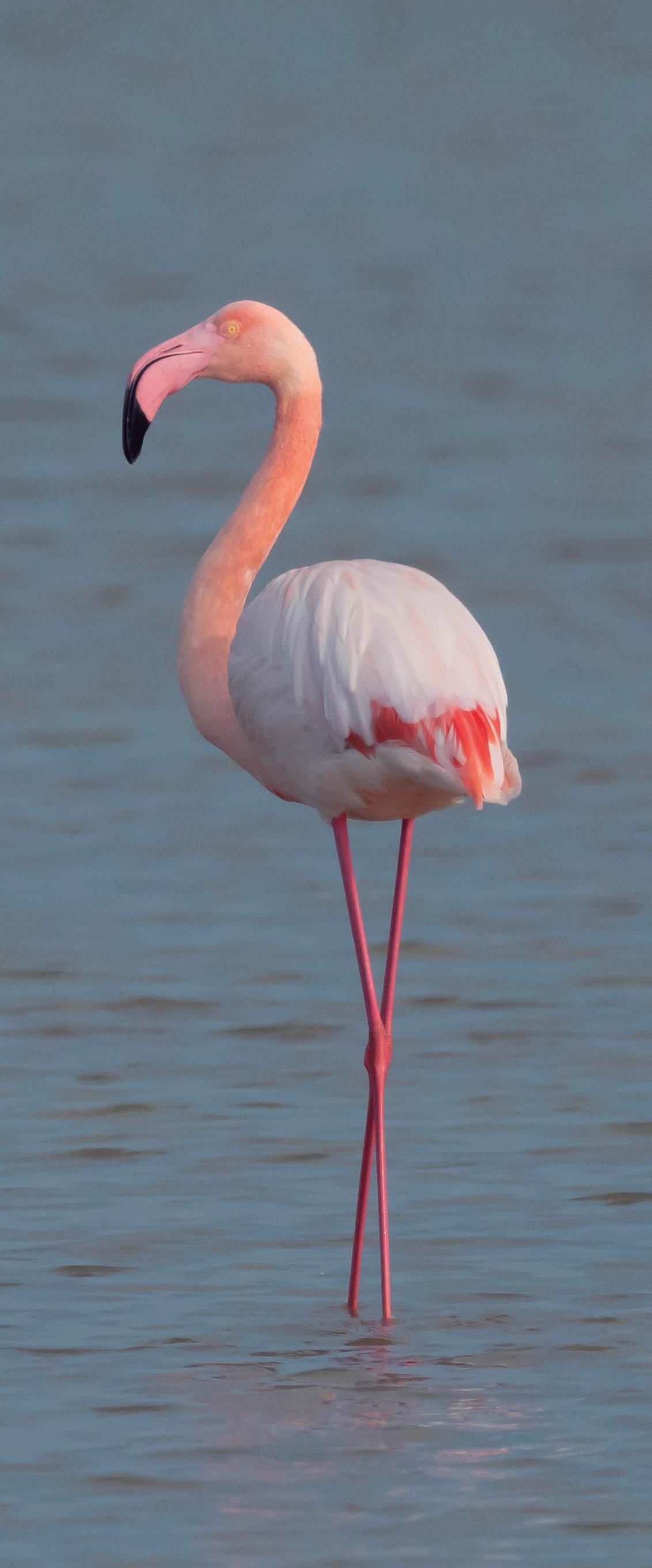
The hustle and bustle of the adults and their constant foraging trips are a good example of the enormous energy expenditure involved in breeding birds. From the observer’s point of view, this hustle of comings and goings gives us a better chance of spotting them.
The chicks of Mallard , Common Pochard, Red-crested Pochard and many other ducks follow their mothers on their excursions around the lake.

Known to local ornithologists as ‘pajareras’, these are breeding colonies (mainly herons and egrets) where birds of different spe cies nest. These tree breeding colonies can be found practically all over the region, but due to their proximity for observation and their variety of species, Glossy Ibis, Cattle Egret, Little Egret, Black-Crowned Night Heron and Squacco Heron, the one located in the poplars and ash trees of the interconnecting channel of La Janda is one of the most spectacular.


Common House Martins, Eurasian Crag Martins, swallows, and swifts of various species, Pallid, Common and Alpine, gather at dusk in the skies above the white villages of the Sierra de Cadiz, creating a magnificent spectacle of flights and sounds. As well as being a gift for our senses, we must not forget that these birds are the most effective form of natural insect control and are of enormous benefit to us.
Known locally as the ‘Caberrubia’, the Rufous-tailed Scrub Robin is one of the most beautiful and, at the same time, most endangered birds in Europe. This unique bird, which comes from Africa to nest in our province, finds shelter in the vineyards of Trebujena, where it can be regularly observed.


Due to the lack of water and therefore of food, the thousands of Greater Flamingos that nest in the Fuente de Piedra lake in Malaga (the largest colony on the peninsula and sometimes in Europe), fly daily to the rich marshes and saltpans of the Bay of Ca diz. With their bellies full of artemia (small crustaceans) and invertebrate larvae, the Flamingos travel hundreds of kilometres every day to feed their offspring.
One of the largest Lesser Kestrel colo nies in the Campo de Gibraltar, in the Parish Church of San Isidro Labrador in Los Barrios, is at its peak of activity. The feeding of the chicks means nonstop ac tion and the excursions of the adults in search of invertebrates, micromammals and reptiles, are a continuous stream of entries and exits to and from the colony.







Binoculars recommended.
Telescope recommended.
On foot. Route or itinerary. By car. Observation Point.
The Medina Lake Nature Reserve (Jerez de la Frontera) is a perfect destination to observe some species of aquatic birds swimming with their offspring.
Due to the extreme proximity to the main road and the consequent danger to the chicks, bird watching and photography on foot is not permit ted under any circumstances. For a correct obser vation, vehicles should be driven at low speed.
In the municipality of Puerto Real, the La Esperanza saltpan is home to a large number of birds, including the iconic Greater Flamingo.
From any of the four viewpoints in the beau tiful village of Setenil de las Bodegas, you can enjoy the flight of martins, swallows and swifts.
Along the path of the Haciendas (Trebujena) and with the help of its distinctive call, we can locate the Rufous-tailed Scrub Robin singing on top of a vine.
An important colony of Lesser Kestrels delights us with their flights in the sky above the parish church of San Isidro Labrador in the town centre of the municipality of Los Barrios.


For a migratory bird, the first jump or crossing of the Strait of Gibraltar is always a critical moment of its life. The wait for optimal weather conditions to successfully overcome this first great challenge, causes spectacular concentrations of birds, which results in a delightful experience for the observer.
The Kentish Plover is the most critically endangered wader breeding in the Bay of Cadiz. Due to its nesting habits among dunes and high beach areas, and more importantly, because of the use that humans make of these places, its observation is becoming increasingly di fficult.

The distinctive song of the Golden Oriole, the striking silhouette of the Griffon Vulture overlooking the Zaframagon Rock (the largest colony in Andalusia) and the flight of the scarce White-rumped Swift that nests in this area, are just some of the many attractions of the Peñon de Za framagon Nature Reserve.

One of the ornithological gems of the province of Cadiz lives concealed among coastal halophyte shrubs in the Trebujena marshes. The Marbled Duck, currently the most critically endangered duck on the continent, finds here optimum conditions for reproduction. This is one of the few nesting sites in Europe.
Young Booted Eagles, Short-toed Snake Eagles and other migrants born in the mountains of Jerez spend the last hours of their short and intense learning pe riod. Knowing how to search for food, choose a roost, master the winds and, in short, learning to survive, will be the key to successfully completing their first migration to Africa.

With the new rice planting season and the good supply of water for growing the crop, birds such as Black-winged Stilts, Green Sandpipers and other waders are visiting the cultivation fields in search of food.

While September is the month many ornithologists choose to observe the glider migration, the sheer size of the huge flocks of White Storks and Black Kites that fill the skies over the Campo de Gibraltar in July is an absolutely unique spectacle. After several days of strong winds, and just as the easterly winds die down, the conditions are ideal for observing the beauty of these migrating flocks.







Binoculars recommended. Telescope recommended.
This Casa de Torres trail runs in the Montes de Propios de Jerez de la Frontera cros sing the very heart of the Los Alcornocales Natural Park. Along this trail we can observe the first flights of many of the birds of prey in the area.
Starting from the municipality of Olvera and walking through olive groves and pastures, we can walk along the limits of the eastern slope of the majestic Zaframagon Rock.
A journey by car along the track that runs alongside the eastern water channel of the old La Janda lake will allow us to observe Black-winged Stilts and many other birds among the rice fields.
From the Los Toruños path (El Puerto de Santa Maria), we can access the Levante beach. Important! To guarantee the protec tion of Kentish Plover, to access the beach you must always follow signposted guidance.
The old saltpan WWF that has restored in the Alventus marsh in Trebujena, in front of the Doñana National Park, is an excellent place to observe the Marbled Duck.
The observatory of Punta Camorro (Tarifa) offers a perfect setting for the observation of gliding birds during their migration across the Strait of Gibraltar.
Most European bird species have already finished their breeding season and bird migration carries on. The increase in the number of species heading for the African continent, make this natural phenomenon more visible.

The glider migration continues at a steady pace. Alongside the usual Black Kites and White Storks, the first Montagus’ Harriers , Egyptian Vultures, Booted Eagles and Short-toed Snake Eagles start their crossing to Africa.


Avoiding the hottest hours of the day, dawn and dusk are the best times to see one of the most beautiful Iberian birds. Given away by its distinctive song, the Pin-tailed Sandgrouse can be usually observed visiting the Alventus marshes in search of water.

On their way to their winter grounds in Africa, terns of various species stopover in the Bay of Cadiz to rest and restore fat reserves. The availability of food in the marshes and saltpans attracts, among others, Common Terns, Little Terns, marsh terns and the rarer Lesser Crested Terns and Roseate Terns.
At the end of summer, water becomes scarce in the seasonal wetlands of the Jerez countryside. The deeper lakes, usually with water at this time of year, are excellent places to watch small migrating birds.

Collared Pratincoles are already preparing for their imminent journey to the south and are spending their last days coming and going around the breeding colony in the Barbate marshes. This is a good time to differentiate between the dull plumage of juveniles and the more colourful plumage of adults.

Due to the special conditions of humidity and temperature in the rivers and streams of the Cadiz mountains, during the summer we can see species that usually nest in more northerly latitudes. These include the European Robin and the Eurasian Blackcap. The juveniles of these two species can be found in the more shady areas of the mountains where the vegetation is richer.







Binoculars recommended. Telescope recommended.
On foot. Route or itinerary. By car. Observation Point.
Among the reedbeds of the Torrox Lake (Je rez de la Frontera) it is possible to see Eura sian Reed Warblers, Melodious Warblers and other small migrating birds.
This path runs between the water channels, marshes and an old restored rubbish dump in the La Breña y Marismas del Barbate Nature Reserve. An unbeatable option for easy observation of the common Collared Pratincole, among other species.
The tern roost at the La Tapa saltpan in El Puerto de Santa Maria is the perfect place to see a large number of species of seabirds and waders.
Between the municipalities of El Bosque and Benamahoma, the Majaceite River trail runs through ash and poplar trees. A refreshing option for bird watching.
Any of the public access roads to the Trebuje na marshes lead to good areas for observing the Pin-tailed Sandgrouse. Due to its wary behaviour, it is important to keep a great distance from the water.
The observatory of Cazalla (Tarifa) is a must for observing the autumn migration of gliding birds on their migratory journey to Africa.
Most European species have finished their breeding season and migration continues to make headway. The increase in the number of species heading towards the African continent makes this natural phenomenon more visible.

In addition to the small resident birds, such as the Common Stonechat and the Sardinian Warbler, September is an exce llent time to observe the small migrants that seek shelter and food among the vegetation of the Cadiz mountains.

On their way to Africa, young European Bee-eaters from all over the Iberian Peninsula rest while waiting for the Levante wind to ease so that they can cross the Strait of Gibraltar. Perched on fences, trees and posts in the La Janda region, the juveniles of this species watch attentively as the adults capture insects on the fly.

European Bee-eaters

The 41-hectare Santa Teresa Park in Jerez de la Frontera dates back to 1826 and was created as a recreational estate for a Jerez family linked to the winemaking sector. Due to its leafiness and proximity to the Guadalete river, this space is a perfect place to observe passerine migration. Species such as the Spotted Flycatcher, the European Pied Flycatcher, the Common Redstart and the Willow Warbler are common among its bushes.

Without a doubt, the mass migration of gliding birds is a phenomenon that in the Campo de Gibraltar takes on dimensions unique in the whole of Europe. Due to its proximity to Africa (14 km), its location between two seas, the Atlantic and the Mediterranean, and its natural spaces, which provide shelter to thousands of birds during their migration, this region is unequalled for the observation of one of the most beautiful natural spectacles on the entire continent.

The corrales (traditional fishing weirs) of the municipalities of Rota and Chipiona are full of life during the migration months. Numerous waders and terns rest here after a long day searching for food and make a stop on their migratory journey to Africa.

From July to November, peaking at the beginning of September, large flocks of Eurasian Spoonbills are observed travelling along the La Barrosa beach on their migratory adventure towards the African continent. As they pass along the coast, mixed groups of adults and juveniles are counted every year by the volunteers of the Limes Platalea Project, who will kindly inform you about the species and their project.






Binoculars recommended.
Telescope recommended.
On foot. Route or itinerary.
By car.
A pleasant walk through Santa Teresa Park (Jerez de la Frontera) will allow us to see and hear a good number of species. It is recommended to consult opening days and hours at the town hall.
This path, with public access through the gate next to the Churriana water channel, allows us to observe Bee-eaters and many other species in migration. An information sign at the start of this trail will tell you all you need to know about it.
Providing spectacular views of the La Barrosa beach, the Torre del Puerco in Chiclana de la Frontera is also the best bird observatory in Eu rope to watch the Eurasian Spoonbill migration.
Observation Point.
The Mediterranean vegetation through which the Camino Alto a El Bosque path runs conceals hundreds of small birds in full migration.
This is a place visited by many birdwatchers, as among the usual flocks of Sandwich, Common and Little Terns, there are hidden gems such as the Elegant and the Lesser Crested Terns.
With a moderate westerly wind, the Algarrobo observatory in Algeciras is the ideal place to observe hundreds of Booted Eagles, Short-toed Eagles, Egyptian Vultures, Eurasian Sparrowhawk, ha rriers, falcons and many other migrating species.

While the last of the summer birds are making the most of their time in the province, the first wintering birds are arriving from their nesting areas in more northerly latitudes. In addition, the rich variety of species that are on their way to Africa, make this month a perfect cocktail for the observer’s enjoyment.
Ferruginous Duck
If the rainfall conditions have been optimal and the land-locked basins of Espera maintain a good level of rain water, the lakes Dulce de Zorrilla, Salada de Zorrilla and Hondilla are undoubtedly some of the best places in the whole province for spotting the scarce Ferruginous Duck, White-headed Duck and Red-knobbed Coot.
Birdwatching Calendar of the Province of Cadiz
With a varied vegetation, consisting mainly of umbrella pine trees, eucalyptus and small patches of Mediterranean scrub, the periurban park of La Suara is home to a varied community of birds.
The good number of parks and gardens in the capital city of Cadiz, their good condi tion and leafiness, attract numerous birds to these urban green spaces during their migration and wintering periods. Among them, the parks Jose Celestino Mutis, Genoves and Kotinoussa (famous for the appearance of an Eyebrowed Thrush at the beginning of 2018) stand out, where it is common to see enthusiasts in search of the different species of flycatchers, warblers and chiffchaffs on migration.

Among the trees or perched on one of the electric cables that exist in the former lake of La Janda , it is still possible to observe the rarest of the continental pigeons, the European Turtle Dove. Although their migration period is coming to an end, it is still a good time to try to spot those that come from more northerly populations.

Flocks of hundreds or even thousands of Griffon Vultures, and Black Vultures to a lesser extent, circle the thermal currents of the Strait of Gibraltar and gain altitude in order to cross to the African continent. This behaviour, which takes place between October and December, relates to the juvenile dispersal of a large part of the vultures born in Spain, Portugal and France, whose main objec tive is to cross the Strait to feed on the large carrion of the African Sahel. This is also the best time of the year to see the rare Rüppell’s Griffon Vulture.

Small birds such as the Tawny Pipit, the Northern Wheatear and the Whinchat can still be seen on their migration sou th. Perched on a bush or wire and using altitude to their advantage, these birds try to locate insects in the vegetation.







Binoculars recommended. Telescope recommended.
A pleasant walk through the La Suara Periurban Park in Jerez de la Frontera will allow us to see a good number of species.
The path that connects the town centre of Espera with the water basins of the Com plejo Endorreico Lagunas de Espera Nature Reserve will provide the observer with a good number of species of high ornithological value.
This route runs along a large part of the La Janda lake, from the Venta Retin junction on the N-IV to the municipality of Benalup Casas-Viejas. The La Janda lake is one of the most popular destinations for birdwatching in the Iberian Peninsula.
With its 22,000 sqm of gardens, the Jose Celestino Mutis Park, also known as the shipyard park, is a magnificent place to spot small migrating birds.
A route by car along the road that links La Algaida (Sanlucar de Barrameda) with Trebujena, will allow us to observe these species during their autumn migration.
Due to their large wingspan, vultures need very particular conditions to be able to migrate between continents. On days with a light north wind, the Strait viewpoint is a great observatory.

Autumn is coming to an end and the drop in temperatures is causing thousands of birds from all over Europe to start their journey south. The good weather and availability of food will make them stay in our province for the next few months.
With the arrival of the wintering birds, the number of Red Kites is increasing and it is common to see the silhouette of this beautiful bird of prey along the marshes.

The only connection between the Mediterranean and the Atlantic, the Strait of Gibraltar, is a magnificent place to watch seabirds. In their comings and goings, different species of shearwaters, auks, puffins, gannets, skuas and storm-petrels can be observed every year on their migrations. The activity of Cory’s Shearwaters, Balearic Shearwaters and other species such as the Northern Gannet is high during this month.

Every year, Ospreys from all over Europe choose the Bay of Cadiz as their wintering place. During their fishing trips, resting on a pole or feeding on a freshly caught fish, this beautiful bird of prey can be spotted all over the region.


A common nester in more northerly lands, the Short-eared Owl is a regular visitor to the La Janda region during the autumn and winter months. Along with other nocturnal birds such as the Barn Owl, the Long-eared Owl and the Tawny Owl, these birds of prey are the best na tural controllers of voles and other rodents.

The end of autumn marks the official start of the mating season of species such as the Eagle Owl and the Tawny Owl. Due to the difficulty of observing them during the day, it is advisable to wait for sunset and listen to their calls in the silence of the night.

The cold is making itself felt and tens of thousands of birds are finding excellent refuge in the cities, where the tempera ture is slightly warmer than in the countryside. Also, the safety provided by the proximity of humans (less presence of predators) makes the parks and buil dings of Jerez de la Frontera magnificent roosts for species such as the White Wagtail and the Eurasian Crag Martin.






As evening falls, the curtain opens and the stage is set with the arrival of hundreds of Eurasian Crag Martins entering their roost in the Luz Shopping Centre. Elsewhere in the city, the show continues as thousands of White Wagtails gather in the trees along the Europa Avenue.
At sunset, the route between the mouth of the Salado river and the Castilnovo meadow in Conil de la Frontera is an excellent place to observe the Short-eared Owl. The old lake of La Janda is also an excellent option to see this species.
A walk along the promenade located next to the Bahia Sur shopping centre in San Fernan do will provide us with sightings of Ospreys, waders and waterfowl. For better visibility due to the sunlight, it is advisable to go in the morning.
Binoculars recommended. Telescope recommended.
The countless forests and cliffs that exist in the Cadiz mountain range are excellent locations to enjoy the courtship displays of nocturnal birds of prey. The recreatio nal area La Muela in Algodonales is a good example of this.
If you follow the track that runs between La Algaida (Sanlucar de Barrameda) and the municipality of Trebujena along the Carril del Practico , it is common to see the flight of the Red Kite.
Due to its geographical location, the island of Tarifa is undoubtedly the best seabird observatory in the region. Authorisation is required to access it, so it is advisable to call the Natural Park or contact the local compa nies that offer guided tours.


Those birds that were still finding food and were coping well with the continental cold, are beginning to feel the need to head south in view of the approaching bad weather.
Due to its proximity to the coast, the Parque de Los Lagos in the Costa Ballena Golf district in Rota is a regular resting place for seagulls and other seabirds that come from the Atlantic escaping the storms. After a big squall, it is undoubtedly the best time to try to spot the few Mew Gulls and Ring-billed Gulls, as well as the small Red-necked Phalarope, which looks for food on the water’s surface.
Due to their early nesting habits, starting earlier than eagles, Griffon Vultures try to occupy the nests of Bonelli’s and Golden Eagles. Securing a good platform and saving themselves the trouble of building a new one is something that many pairs of vultures try to do every year. The eagles, always with an eye on their territory, will try at all costs to prevent the vultures from succeeding.

The arrival of the winter storms is synonymous with ornithological surprises. If you look closely among the usual Ru ddy Turnstones looking for food on the rocks of La Caleta and the San Sebastian Castle in the city of Cadiz , you can find one of the rarest waders that visit our country: the Purple Sandpiper.

With 90 % of its area in the municipality of Jerez de la Frontera, Los Tollos is the second largest lake in the province of Cadiz. This seasonal wetland, which hosts an important community of aquatic birds, stands out for receiving a large number of ducks, coots and waders du ring the winter period.

Due to its strategic geographical location, at the foot of the Rock of Gibral tar, in the south of Europe and between the Mediterranean and the Atlantic, the Princesa Sofia Park in La Linea de la Concepción is one of the best places in Spain for the observation of rare species. The Yellow-browed Warbler, the Olive-backed Pipit, the Rosy Starling and the Little Bunting are just some of the gems that have recently appeared in this park.

Although the first arrivals are in mid-October, it is in December when the highest concentrations of Common Cranes (between 2,000 and 3,000 individuals) are recorded in what was once the largest lake on the Iberian Peninsula. The La Janda lake, where the species nested regularly until its drying up in the 1960s, receives every year Cranes from countries such as Estonia, Finland, Sweden and Poland, among others.







Binoculars recommended. Telescope recommended.
On foot. Route or itinerary.
By car. Observation Point.
A nice visit to Los Tollos lake (Jerez de la Frontera) can offer us good numbers of waterfowl, coots and waders
From Las Palomas Mountain Pass, a regular haunt of Griffon Vultures and large eagles, you can see how the Bonelli’s Eagle tries to chase away anyone who dares to approach its territory.
A walk along the eastern channel in the old lake of La Janda will give us the chance to enjoy the sight of the beautiful Common Cranes and to hear their trumpeting calls.
A pleasant walk along the path of the Costa Ballena Golf Resort lakes will allow us to get close to groups of gulls. It is recommended to keep a certain distance so as not to dis turb the birds while they are resting.
At low tide, on the rocks that emerge at La Caleta beach and the San Sebastian Castle in the city of Cadiz, it is possible to observe the Purple Sandpiper among the flocks of Ruddy Turnstones.
A walk through the Princesa Sofia Park in the town of La Linea de la Concepcion will provide us with sightings of species such as the Common Chiffchaff or the Meadow Pipit. If we are very attentive, we may even find some rare species.
Rufous-tailed
Rufous-tailed
Iberian
Plaza Alameda de La Cruz, 14. C.P. 11180 T. +34 956 420 330 ayuntamiento@alcaladelosgazules.es
OFICINA MUNICIPAL DE TURISMO Calle Real, 71. C.P. 11693 T. +34 856 099 233 valledecultura@gmail.com
ALGAR Plaza de la Constitucion, 1. C.P. 11639 T. + 956 710 001 ayuntamiento@algar.es

Av. De Andalucia, 2. C.P. 11680 T. + 34 956 137 003 cultura@algodonales.es
ARCOS DE LA FRONTERA
OFICINA MUNICIPAL DE TURISMO Cuesta de Belen, 5. C.P. 11630 T. +34 956 702 264 turismo@arcosdelafrontera.es www.turismoarcos.es
OFICINA MUNICIPAL DE TURISMO
Paseo Rio de la Miel, s/n. C.P. 11207
T. +34 670 949 047 turismoalgeciras@gmail.com
OFICINA DE TURISMO DE LA JUNTA DE ANDALUCIA
Paseo Rio de la Miel, s/n. C.P. 11207 T. +34 670 949 047 otalgeciras@andalucia.org www.andalucia.org
OFICINA MUNICIPAL DE TURISMO
Paseo MarItimo, 5. C.P. 11160 T. +34 956 063 613 turismo@barbate.es www.turismobarbate.es
OFICINA MUNICIPAL DE TURISMO Calle Huelva s/n. C.P. 11190 T. +34 956 417 733 oficinaturismo@benalupcasasviejas.es
Plaza de las libertades, 1. C.P. 11612 T. +34 956 125 506 ayuntamiento@benaocaz.es
OFICINA MUNICIPAL DE TURISMO Palacio de los Ribera Plza. Alcalde Jose Gonzalez, 2. C.P. 11640 T. +34 956 728 264 turismodebornos@bornos.es www.turismodebornos.com
CADIZ CENTRO DE RECEPCION DE TURISTAS DEL AYUNTAMIENTO DE CADIZ Paseo de Canalejas s/n. C.P. 11006 T. +34 956 241 001 info.turismo@cadiz.es www.cadiz.es
OFICINA DE TURISMO DE LA JUNTA DE ANDALUCIA Avenida 4 de Diciembre de 1977 s/n. C.P. 11006 T. +34 956 203 191 otcadiz@andalucia.org www.andalucia.org
CASTELLAR DE LA FRONTERA Plaza de Andalucia s/n C.P. 11350 T. +34 956 693 001 ayuntamiento@castellardelafrontera.es
PATRONATO MUNICIPAL DE TURISMO Carretera, 1. C.P. 11140 T. +34 956 440 501 turismo@conil.org www.turismoconil.org
OFICINA MUNICIPAL DE TURISMO
Centro de interpretacion del Vino y la Sal Plaza de las Bodegas, s/n. C.P. 11130 T. +34 956 535 969 turismo@chiclana.es www.turismo.chiclana.es
OFICINA MUNICIPAL DE TURISMO
Castillo de Chipiona. C/ Castillo, 7 C.P. 11550 T. +34 956 929 065 turismo@aytochipiona.es www.turismodechipiona.com
CENTRO DE VISITANTES DE EL BOSQUE
C/ Federico Garcia Lorca s/n. C.P. 11670 T. +34 956 709733 cvelbosque.amaya@juntadeandalucia.es
PUNTO DE INFORMACION Calle Alta, 2 T. +34 956 123 815 turismo@elgastor.es
ESPERA OFICINA MUNICIPAL DE TURISMO Calle Los Toros s/n. C.P.11648 T. +34 691 369884 www.turismoespera@gmail.com
EL PUERTO DE SANTA MARIA
OFICINA MUNICIPAL DE TURISMO Palacio de Aranibar Plaza Alfonso X El Sabio, 9. C.P. 11500 T. +34 956 483 714 turismo@elpuertodesantamaria.es www.turismoelpuerto.com
CENTRO DE INFORMACION TURISTICA Plaza Asomadero, 3. C.P. 11610 T. +34 956 132 052 turismograzalema@gmail.com
OFICINA MUNICIPAL DE TURISMO Plaza del Arenal s/n. C.P. 11403 T. +34 956 149 863 turismoinfo@aytojerez.es www.turismojerez.com
OFICINA MUNICIPAL DE TURISMO
Calle San Juan s/n. C.P. 11170 T. +34 956 412 404 oficinadeturismo@medinasidonia.com www.turismomedinasidonia.es
Sevilla, 61. C.P. 11330 T. +34 956 640 254 ayuntamiento@jimenadelafrontera.es www.turismojimenadelafrontera.es
OFICINA MUNICIPAL DE TURISMO Avenida Principe de Asturias s/n. C.P. 11300 T. +34 662 361 328 turismo@lalinea.es
OFICINA DE TURISMO DE LA JUNTA DE ANDALUCIA Avda. del Ejercito, esquina con Avda. 20 de Abril s/n. C.P. 11300 T. +34 956 784 135 otlalinea@andalucia.org
OFICINA MUNICIPAL DE TURISMO Ctra. de acceso a Los Barrios - salida 85. C.P. 11370 T. +34 956 582 504 delegaciondeturismo@ayto-losbarrios.es www.turismolosbarrios.com
OFICINA MUNICIPAL DE TURISMO Plaza Rafael Alberti, 4. C.P. 11510 T. +34 856 213 362 turismo@puertoreal.es www.turismo.puertoreal.es
OFICINA MUNICIPAL DE TURISMO Plaza de la Iglesia s/n. C.P. 11690 T. +34 956 120 816 turismolvera@gmail.com www.turismoolvera.es
PATERNA DE RIVERA Plaza de la Constitucion, 1. C.P. 11178 T. +34 956929012 paterna@dipucadiz.es
OFICINA MUNICIPAL DE TURISMO
Calle Fuente s/n. C.P. 11660 T. +34 956 724 436 turismo.pradodelrey@dipucadiz.es turismo@pradodelrey.es www.pradodelrey.org
PUERTO SERRANO
Plaza Miguel Rodriguez Rivera, s/n. C.P. 11659 T. +34 956 127 042 puertoserrano@dipucadiz.es
ROTA OFICINA MUNICPAL DE TURISMO C/ Compas del Convento, 10. C.P. 11520. Torre de la Merced. T. +34 956 846 345 turismorota@gmail.com www.descubrerota.com
OFICINA MUNICIPAL DE TURISMO
Calle Real, 26. C.P. 11100 T. +34 956 944 226 turismo@sanfernando.es www.turismosanfernando.es
SAN JOSE DEL VALLE Plaza de Andalucia, 15. C.P. 11580 T. +34 956 929 006 ayuntamiento@sanjosedelvalle.es
SAN MARTIN DEL TESORILLO
La Fabrica, 16. C.P. 11340 T. +34 956 618 096 ayuntamiento@sanmartindeltesorillo.es
SANLUCAR DE BARRAMEDA
OFICINA MUNICIPAL DE TURISMO Calzada Duquesa Isabel s/n. C.P. 11540 T. +34 956 366 110 sanlucarturismo@gmail.com www.sanlucarturismo.com

OFICINA MUNICIPAL DE TURISMO
Palacio de los Gobernadores C/ RubIn de Celis, 1. C.P. 11360 T. +34 956 694 005 turismo@sanroque.es www.turismosanroque.es
SETENIL DE LAS BODEGAS
Calle Villa, 1. C.P. 11692 T. +34 946 134 004 ayuntamiento@setenildelasbodegas.es www.turismodesetenil.com
OFICINA MUNICIPAL DE TURISMO
Paseo de la Alameda s/n. C.P. 11380 T. +34 956 680 993 turismo@aytotarifa.com www.turismodetarifa.com
TREBUJENA Plaza España, 1 C.P. 11560 T. +34 956 395 028 ayuntamiento@trebujena.com
Plaza Constitucion, 1. C.P. 11691 T. +34 125134 torrealhaquime@dipucadiz.es
OFICINA MUNICIPAL DE TURISMO Moreno de Mora, 19 A. C.P. 11600 T. +34 956 464 900 oficina.turismo@ayuntamientoubrique.es www.ubriqueturismo.es
OFICINA MUNICIPAL DE TURISMO Avda. de los Remedios, 2 . C.P. 11150 T. +34 956 451 736 Info@turismovejer.es www.turismovejer.es
VILLALUENGA DEL ROSARIO Calle Real, 19. C.P. 11611 T. +34 956 460 001 ayuntamiento@villaluengadelrosario.es
OFICINA MUNICIPAL DE TURISMO Plaza del Ayuntamiento, 10. C.P. 11650 T. +34 956 733 555 culturavillamartin@gmail.com
ZAHARA DE LA SIERRA OFICINA MUNICIPAL DE TURISMO Camino Nazari. C.P. 11688 T +34 956 123 004 turismo@zahara.es
Paraje de Santa Leocadia.Ctra. Camposoto
11.100 San Fernando
Telf: 0034 956 243 474 - 0034 673 766 136 cvbahiacadiz@weyas.es
C. DE VISITANTES HUERTA GRANDE Carretera N-340 (Malaga-Cadiz), km. 96 - Aldea Pelayo
11.390 Algeciras
Telf: 0034 956 024 600 - 0034 671 590 887 huertagrande@ornitour.com





Telf: 0034 671 596 146 elestrecho@ocioynaturaleza.com



Avenida del Mar , s/nº. 11160 Barbate
Telf. 0034 956 459 780 p.i.brenaymarismasdelbarbate@gmail.com
11.180 - Alcala de los Gazules Telf: 0034 856 587 508 / 956 459 780 cv_algibe@juntadeandalucia.es
CENTRO DE VISITANTES EL BOSQUE C/ Federico Garcia Lorca, 1 – Plaza de Toros 11.670 El Bosque. Telf: 0034 956 709 733 cv_elbosque@agenciamedioambienteyagua.es
11.540 Sanlucar de Barrameda Telf. 0034 956 386 577 en.donanada-cvfabricahielo.cmaot@juntadeandalucia.es
Telf: 0034 637 372 755 aviturismoes@gmail.com www.aviturismo.es
Telf: 0034 650 461 041 Telf: 0034 655 81 79 54 info@donanabirdwatching.com www.donanabirdwatching.com
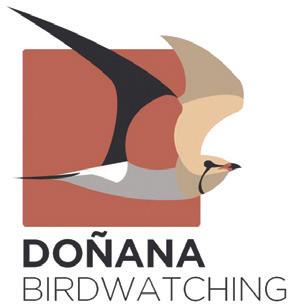
Telf: 0034 650 461 041 Telf: 0034 650 271 407 info@birdingtarifa.es www.birdingtarifa.es



Telf: 0034 667 586 844 info@oxyura.es oxyura.es

Telf: 0034 687 959 256 info@martinete.eu www.martinete.eu

Telf: 0034 699 470 467 Telf: 0034 669 104 869 info@birdingthestrait.com www.birdingthestrait.com

Telf: 0034 609 534 426
Telf: 0034 659 542 065 birding@ornitour.com www.ornitour.com

14 KM TARIFA tarifa14km@gmail.com
AMIGOS DEL BOSQUE, ACCION LOCAL amigosdelbosqueaccionlocal@gmail.com amigosdelbosque.wordpress.com

ASOCIACION AMIGOS DE LA LAGUNA DE LA JANDA lajanda@lagunalajanda.es www.lagunalajanda.org

AGADEN. ECOLOGISTAS EN ACCION agadenprovincia@gmail.com www.facebook.com/salvemoschorlitopatinegro



ASOCIACIÓN LOS LOCOS DEL PARQUE locosdelparque@gmail.com www.loslocosdelparque.org
A. MEDIOAMBIENTAL AMIGOS DEL PARQUE LOS TORUÑOS-BAHÍA DE CADIZ amigosparquebahia@gmail.com
A. MEDIOAMBIENTAL O-LIVE info@olivemedioambiente.org www.olivemedioambiente.org
ASOCIACION DE VOLUNTARIOS TRAFALGAR voluntarios_trafalgar@hotmail.com www.trafalgarsite.com

BIRDCADIZ info@birdcadiz.com www.birdcadiz.com www.birdcadiz.blogspot.com
COLECTIVO ORNITOLOGICO CIGÜEÑA NEGRA cocn@tarifainfo.com http://cocn.tarifainfo.com

FUNDACION MIGRES info@fundacionmigres.org www.fundacionmigres.org


GRUPO ORNITOLOGICO DEL ESTRECHO goes@grupoornitologicodelestrecho.org www.grupoornitologicodelestrecho.org
GRUPO ORNITOLOGICO TUMBABUEY tumbabuey@gmail.com SALARTE contacto@salarte.org www.salarte.org


SOCIEDAD GADITANA DE HISTORIA NATURAL sghn96@gmail.com www.sociedadgaditanahistorianatural.com

PROYECTO LIMES PLATALEA - SGHN limes.platalea@gmail.com http://limesplatalea.blogspot.com/



Parque Natural Sierra de Grazalema
Parque Natural Bahía de Cádiz
Parque Natural La Breña y Marismas del Barbate
Parque Natural Los Alcornocales
Parque Natural El Estrecho
Paraje Natural Cola del Embalse de Bornos
Reserv a Natural Complejo Endorreico de Espera
Reserv a Natural Complejo Endorreico del Puerto de Santa María
Paraje Natural Cola del Embalse de Arcos
Monumento Natural Peña de Arcos
Reserv a Natural Laguna de Medina
Parque Periurbano La Suara
Parque Periurbano Dunas de San Antón
Paraje Natural Isla del Trocadero
Paraje Natural Marismas de Sancti Petri
Monumento Natural Punta del Boquerón
Parque Periurbano La Barrosa
Reserv a Natural Laguna de Las Canteras y Tejón
Reserv a Natural Complejo Endorreico de Puerto Real
Reserv a Natural Complejo Endorreico de Chiclana
Reserv a Natural Concertada Laguna de La Paja
Monumento Natural Peñón de Zaframagón
Paraje Natural Estuario de Río Guadiaro
Monumento Natural Tómbolo de Trafalgar
Monumento Natural Duna de Bolonia
Paraje Natural Playa de Los Lances
Paraje Natural Marismas del Río Palmones
Published by
PATRONATO PROVINCIAL DE TURISMO
DIPUTACION DE CADIZ Plaza de Madrid s/n Nuevo Mirandilla – Fondo Sur 4ª planta. 11011 Cadiz Telf: 0034 956 807 061 info@cadizturismo.com www.cadizturismo.com
Manuel Morales Holgado (Birding Tarifa)
Manuel Morales Holgado & Fernando Gomez Tineo
Marcelina Romo Caro
MILVUS MEDIO AMBIENTE, SL
Manuel Morales Holgado
Except:
Ricky Owen: Rufus-tailed Scrub Robin (page 10 y 47).
Gonzalo Gil Marques: Purple Sanpiper (page 71).
Victor Manuel Gonzalez Porras: Eyebrowed Thrush (page 63). Alex Colorado Delgado: Olive-backed Pipit (page 72). Jose Antonio Orellana Mesa: Eagle Owl (page 68).
Fernando Gomez Tineo: Bonelli’s Eagle (page 9), Little Owl (page 30), Eurasian Spoonbill (page 31), Lesser Kestrel (page 34), Common Cuckoo (page 38), Black-winged Stilt (page 50) and Eurasian Wryneck (page 54).
Martinez encuadernaciones A.G., S.L.
Legal deposit CA 293-2022
www.cadizturismo.com